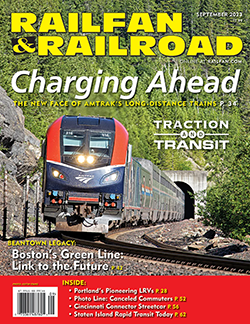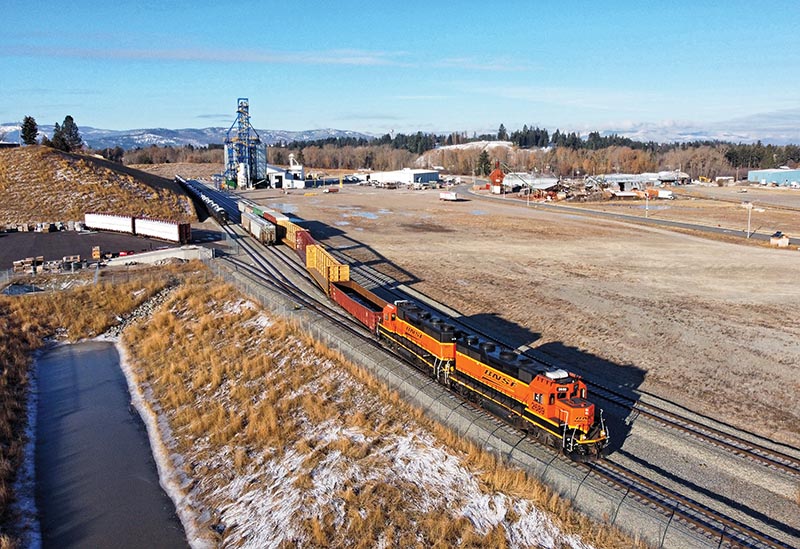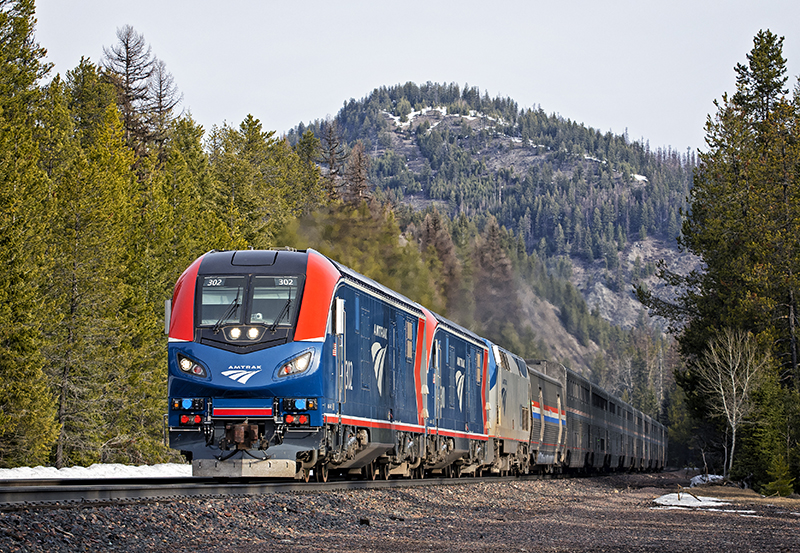 by Justin Franz/photos by the author
by Justin Franz/photos by the author
As I prepared the photos for my recent feature on Amtrak’s new ALC-42 locomotives, I realized I didn’t have a good photo of the units at Stanton Creek, Mont. That’s not to say I didn’t have a photo of the flashy new locomotives there — I had a few — but there were some problems with them.
The first time I got the Chargers at Stanton Creek, I had the wrong leader — specifically, I had locomotive 302. The 302 was the first ALC-42 to lead a train in early 2022 on the Empire Builder, but just outside of Seattle it struck a truck at a crossing, damaging the locomotive’s nose cone. When it got back to Chicago, a new nose cone was popped on the locomotive and it was sent back to work. But there’s a big problem with that specific nose cone — it doesn’t have the white stripe all the other ALC-42s have. (Why Amtrak didn’t put the stripe on the replacement cone is beyond me.) I never actually noticed the lack of nose stripe until Matt Donnelly, Amtrak’s brand communications manager, pointed it out to me, and now it’s all I can see when I look at 302. So that photo was out. The second time I shot a Charger at Stanton Creek, I actually had the perfect locomotive for it — “Day 1” heritage unit 301 — but a hazy sky defused the light, so that shot didn’t work either.
I’m generally not that picky. Just the other night, for example, my wife ordered a sausage, pepperoni, pepper, and onion pizza — by no means my favorite, but I ate it nonetheless. But one area when I do get picky is when I’m attacking a photo project, and for the last 18 or so months the ALC-42 locomotives have been a pet project of mine. And when I adopt something as a “project,” I want to shoot it from every possible angle and I want to make those images as perfect as can be.
I was first introduced to the idea of project photography by my dad. When I was younger, I always wanted to see new railroads and different locations. But because I wasn’t paying for gas or doing any of the driving, we usually shot what Dad wanted to shoot, which meant repeat visits to the Rockland Branch (the state-owned former Maine Central branch that was operated by Maine Coast Railroad in the 1990s) or the former Canadian Pacific across western Maine. Both of those were his “projects” and that meant we would make dozens of visits to each during different seasons with different weather trying to get as many unique shots as possible. Dad wasn’t content with getting a few token shots. He wanted to cover those lines like few others had, so if anyone ever said, “Hey, can you put a slide show or article together about [insert railroad/locomotive/region here]?” he could confidently say, “Yes.”
 When the author began shooting BNSF’s locals in northwest Montana, he knew he needed a shot of the Kalispell Job working the grain elevator in Evergreen, such as in November 2020.
When the author began shooting BNSF’s locals in northwest Montana, he knew he needed a shot of the Kalispell Job working the grain elevator in Evergreen, such as in November 2020.
Of course, Tim Franz didn’t invent the idea of project photography; he was just copying what some of the well-known shooters in our hobby were doing. As Elrond Lawrence pointed out here in Camera Bag back in January (see “Lessons from Stein”), Richard Steinheimer “was a champion of returning to the same place again and again to get the pictures needed to tell a complete story in his projects.” For example, in the 1960s, Southern Pacific’s PA locomotives were a focus of Steinheimer’s, and while the lineside images of smoke-belching Alcos were the heart of that effort, it would have been lacking something had Stein not returned to get images of SP employees keeping those beasts in service at the locomotive facility in Oakland, Calif. Stein often referred to the idea of going back to a subject time and time again as “layering.”
Another photographer who practiced “layering” was John E. Gruber, founder of the Center for Railroad Photography & Art. Gruber photographed countless railroads and places, but it’s his work on a select few subjects — Chicago Union Station; Chicago, North Shore & Milwaukee; Green Bay & Western; and the Rio Grande narrow gauge — for which he’ll be most remembered. In each of those instances, Gruber made multiple visits to the same place getting to know the locations, the angles, the lighting, and — perhaps most importantly — the people who made those railroads work. Those people would not only become invaluable in providing information that could lead to unique images but became subjects of photos themselves, helping tell a complete story.
Over the years, I’ve had a few “projects” of my own. Canadian Pacific across Maine and the Rockland Branch have certainly been interests of mine over the decades, but, of course, that’s mostly piggybacking off what Dad has done. If you want a slide show of the last 30 years on the former MEC between Brunswick and Rockland, don’t ask me, ask him.
The former Great Northern in northwest Montana has been perhaps my biggest personal project, especially the line through Kalispell, part of which was ripped up a few years ago to make way for a trail. Not long after it was announced that about two miles of track through downtown would be ripped up (the surviving rail customers were moved to a taxpayer-funded industrial park east of town), I decided that the rails through Kalispell would be a project and I began shooting Mission Mountain Railroad’s local there as much as I could. At the time, I was working at a newspaper downtown, so running out to nab a few photos every other day was pretty easy. After I had checked off most of the lineside angles, I rode along with the train crew to get images on board and of the employees. I then began to seek access to the industries themselves — a grain elevator and a drywall distributor — to record what those operations were like.
Eventually, I created an in-depth record of the railroad there and began to ease off my efforts. That was, until the final few runs in late 2019, when I again started going out as often as I could to capture the end. Even after the trains stopped running and the rails were ripped up, I’ve gone back to Kalispell to get photos of the trail construction and developments that are springing up alongside it. Even if the trains are gone, there’s still a story to be told and photos to be captured. (For those who are curious, I published a story about that project online. You can check it out at kalispellrailroad.com.)
Another project that had occupied me over the last few years was photographing BNSF’s locals in and out of Whitefish. In some ways, this was a continuation of that Kalispell project because, in 2020, BNSF reclaimed from Watco the branch from Columbia Falls to Kalispell. Besides trying to get the local at some of the more notable locations it passes, I emphasized images of it switching the various industries it serves, from the industrial park in Kalispell to the lumber mill in Columbia Falls. At the end, I wanted to have enough images to put together a complete story, which I did in the April 2022 edition of this magazine.
Which brings us back to that ALC-42 project I was talking about earlier. Ever since the first run back in early 2022, I knew I wanted to focus some photography efforts on the locomotive’s debut on the Empire Builder. For starters, that meant shooting the locomotives in as many different locations as possible on Marias Pass, arguably one of the most famous locations the train traverses on its daily run from Chicago to Portland, Ore., and Seattle, Wash.
I also tried to shoot the locomotives in different conditions, from bright sunny days to dark winter storms. I wanted down-low angles that emphasized the locomotives themselves and dramatic aerial views that put them in the context of the territory they were operating in. I also wanted images of them with people, so getting a few photos of them at Whitefish (one of the busiest stops on the entire route and a crew change point) was critical. Detail shots were another important consideration.
Some railroad photographers want to try and see as many different railroads and locations as they can. I get that. Part of the fun of this hobby is experiencing new places. But oftentimes, I find the biggest reward photographically is revisiting locations and subjects I’m familiar with over and over again in search of that perfect photo — a photo that can help tell a story. Ultimately, when I look at my photo collection, I really hope I’m able to find deep coverage of a few things, rather than shallow coverage of a lot of things.
Anyway, if you would excuse me, I’ve gotta check the weather for Stanton Creek tomorrow morning…



